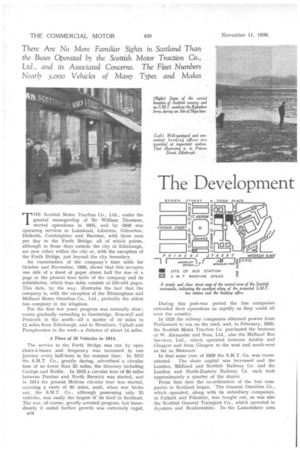The Development
Page 156

If you've noticed an error in this article please click here to report it so we can fix it.
THE Scottish Motor Traction Co., Ltd., under the general 'managership of Sir William Thomson, started operations in 1905, and by 1906 was operating services to Loanhead, Liberton, Gilmerton, Dalkeith, Corstorphine and Barnton, with three runs per day to the Forth Bridge, all of which points, although in those days outside the city of Edinburgh, are now either within the city or, with the exception of the Forth Bridge, just beyond the city boundary.
An examination of the company's time table for October and November, 1906, shows that this occupies one side of a sheet of paper about half the size of a page in the present time table of the company and its subsidiaries, which time table consists of 550-odd pages. This date, by the way, illustrates the fact that the company is, with the exception of the Birmingham and Midland Motor Omnibus Co., Ltd., probably the oldest bus company in the kingdom.
For the first few years progress was naturally slow; routes gradually extending to Gorebridge, Rosewell and Penicuik in the south---all a matter of 10 miles to 11 miles from Edinburgh, and to Broxburn, Uphall and Pumpherston in the west—a distance of about 14 miles.
A Fleet of 35 Vehicles in 1914.
The service to the Forth Bridge was run by open chars-a-bancs and frequency was increased to one journey every. half-hour in the summer time. In 1912 the S.M.T. Co., greatly daring, advertised a circular tour of no fewer than 35 miles, the itinerary including Carlops and Roslin. In 1913 a circular tour of 60 miles between Dunbar and North Berwick was started, and in 1914 the present Melrose circular tour was started, covering a route of 90 miles, until, when war broke out, the S.M.T. Co., although possessing only 35 vehicles, was easily the largest of its kind in Scotland. The war, of course, greatly arrested progress, but immediately it ended further growth was extremely rapid. ,4 simple and clear street map of the central area of the Scottish metropolis, indicating the excellent siting of the projected S.M.T. bus station and the booking office.
During this post-war period the bus companies .extended their operations as rapidly as they could all over the country.
In 1928 the railway companies obtained powers from Parliament to run on the road, and, in February, 1929, the Scottish Motor Traction Co. purchased the business of W. Alexander and Sons, Ltd., also the Midland Bus Services, Ltd., which operated between Airdrie and Glasgow and from Glasgow to the west and south-west as far as Stranraer.
In that same year of 1929 the S.M.T. Co. was reconstituted. The share capital was increased and the London, Midland and Scottish Railway Co. and the London and North-Eastern Railway Co. each took approximately a quarter of the shares.
From that (late the co-ordination of the bus companies in Scotland began, The General Omnibus Co., which operated, along with its subsidiary companies, iri Falkirk and Fifeshire, was bought out, as was also the Scottish General Transport Co., which operated in Ayrshire and Renfrewshire. 'Ill the Lanarkshire area




























































































































































